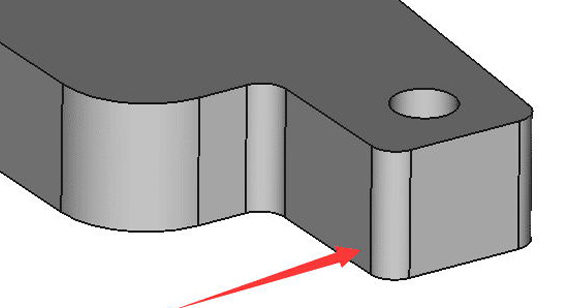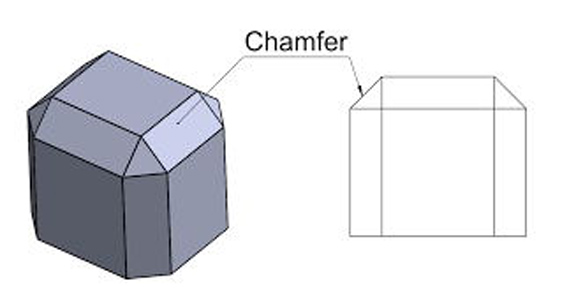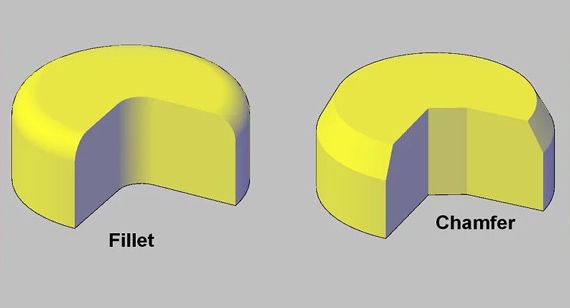15 years one-stop China custom CNC machining parts factory
 557 |
Published by VMT at Aug 17 2024
557 |
Published by VMT at Aug 17 2024
In CNC machining, fillets and chamfers are common edge treatments that significantly impact product performance, appearance, safety, and machining efficiency. This article aims to provide an in-depth analysis of fillets and chamfers, covering their definitions, design, uses, differences, and implementation methods in AutoCAD. It will help engineers and designers make more informed decisions in CNC machining processes.
A fillet is a process of rounding the edges of a part, typically to reduce stress concentrations, enhancing the durability and safety of the component. In CNC machining, fillets can be created using milling, turning, or wire-cutting methods.

Designing a fillet in AutoCAD is intuitive. By using the “FILLET” command, users can specify the radius of the fillet and select the edges to apply it. AutoCAD automatically calculates and generates the desired fillet shape. Users can also adjust the size and position of the fillet to meet design requirements.
Stress Concentration: Fillets significantly reduce stress concentration at the edges, improving fatigue strength and durability.
Ease of Manufacturing: Filleted edges are easier to machine than sharp edges, reducing tool wear and machining time.
Assembly: Fillets facilitate smooth assembly, reducing the risk of damage caused by edge friction.
Safety and Comfort: Fillets reduce the risk of injury in human-machine interactions and enhance ergonomic comfort.
Aesthetics: Fillets often give products a softer, rounded appearance, improving overall visual appeal.
A filleted edge appears as a smooth, rounded arc, with the radius adjustable according to design needs. This edge not only looks pleasing but also offers practical advantages in various applications.
From an aesthetic standpoint, filleted edges can indeed give products a more rounded and softer appearance, enhancing visual appeal. However, attractiveness depends on the specific design style and audience preference.
Benefits:
Challenges:
May increase machining difficulty and cost in specific cases, such as when precise control over dimensions is required. Overuse of fillets might also make a product appear overly soft, losing the desired sharpness.
A chamfer is the process of cutting a sloped edge, typically at a 45-degree angle, to remove sharp edges, facilitate assembly, or improve appearance. Common chamfer types include 45-degree and 60-degree chamfers.

Deburring: Chamfers effectively remove burrs and sharp edges, improving surface quality.
Assembly: Chamfers aid in smooth assembly, reducing the risk of damage due to edge friction.
Stress Reduction: Although not as effective as fillets, chamfers can reduce stress concentration to some extent.
Aesthetics: Chamfers give products a clean, sharp look, suitable for modern design styles.
A chamfered edge has a sloped surface at a specified angle, with the angle and length adjustable to meet design needs. This edge not only looks clean but also serves practical functions like deburring and facilitating assembly.
Creating a chamfer in AutoCAD is also straightforward. Using the “CHAMFER” command, users can specify the angle and distance or select two adjacent edges to apply the chamfer. AutoCAD automatically calculates and generates the desired chamfer shape.
From a machining cost perspective, chamfering is usually cheaper than filleting because it requires less cutting and doesn’t need to form a full arc. However, the exact cost depends on factors such as part shape, size, material, and machining method.
The chamfer angle doesn’t have to be 45 degrees. It can be any angle depending on design and assembly requirements. However, 45-degree chamfers are widely used for their simple, symmetrical appearance.
Benefits:
Challenges:
Can be challenging in high-precision assemblies or when specific aesthetic requirements exist.
Safety: Fillets and chamfers reduce the risk of injury from sharp edges, enhancing product safety.
Process Requirements: In CNC machining, fillets and chamfers are part of the manufacturing process. They simplify production, reduce machining difficulty, and improve efficiency. Sharp edges can cause rapid tool wear, increasing downtime and maintenance costs, while fillets and chamfers can extend tool life and reduce machining costs.
Decorative Purposes: Fillets and chamfers are widely used to enhance the overall aesthetics and visual appeal of products. They balance product lines, making them look more harmonious and smooth, aligning with modern aesthetic trends.
Fillets are preferred when:
Parts are under high stress: Fillets distribute stress more effectively, reducing the risk of cracking or damage.
Aesthetic parts: Fillets improve the product's attractiveness and appeal, especially for consumer-facing items.
The benefits outweigh the costs: In some cases, the durability, safety, and aesthetics of fillets justify the higher machining costs.
Chamfers are preferred when:
Parts are not under high stress: Chamfers are a cost-effective edge treatment for less stressed parts.
Mating parts: Chamfers ensure smooth assembly, reducing friction and resistance during assembly.
Lower costs are needed: Chamfers typically offer cost advantages, especially in high-volume production.
Other Considerations:
Adding Fillets and Chamfers to Holes: Chamfering holes for screws or bolts ensures smooth thread insertion, reducing the risk of thread damage.
Engineering Decisions: When choosing between chamfers and fillets, consider the part's function, material, environment, and machining costs.
Fillets and Chamfers on Part Edges: Both external and internal edges can be treated with fillets and chamfers to improve durability, safety, and appearance.
CNC Milling Parts Manufacturing: CNC milling provides efficient, precise solutions for creating complex shapes with fillets and chamfers. However, sharp internal corners may require special machining strategies or tools.
Adding Fillets and Chamfers to Mating Parts: Proper fillet and chamfer design in mating parts ensures smooth and tight assembly.
For Inclined and Angled Surfaces: Special attention is required when adding fillets and chamfers to these surfaces to maintain aesthetic and functional integrity.
Fillets and chamfers are common edge treatments that differ in shape, function, and application. Fillets are rounded, while chamfers are angled. Their applications differ, with fillets being better suited for stress distribution and aesthetics, and chamfers for deburring, assembly simplification, and cost reduction.

Application Comparison: Fillets are ideal for stress distribution and aesthetic enhancement, while chamfers are best for deburring, assembly, and cost efficiency.
Aesthetics: Fillets provide a rounded, soft look, whereas chamfers offer clean, sharp lines. Both have unique aesthetic advantages depending on design style and audience preference.
Manufacturability: Chamfers are generally easier and less expensive to produce than fillets. However, fillets might be more complex and time-consuming to machine, especially in high-precision applications.
Safety: Fillets reduce the risk of injury from sharp edges more effectively than chamfers, making them safer for products involving human interaction.
Specific Dimensions: The dimensions of fillets and chamfers (radius, angle, and length) must be calculated and adjusted according to the part's specific function and design requirements.
Production Costs: Fillets and chamfers' costs depend on factors such as part size, material, machining method, and time. Choosing the appropriate edge treatment can help reduce production costs.
Edges: The edge shapes of fillets and chamfers directly impact the appearance and performance of parts. Filleted edges are smooth and rounded, enhancing overall aesthetics and ergonomics, while chamfered edges are angular, providing a clean, defined look.
Stress Concentration: Fillets effectively reduce stress concentration, improving fatigue strength and durability, while chamfers offer limited stress reduction.
Machining Time: The machining time for fillets and chamfers depends on the specific method and precision requirements. Generally, filleting takes longer due to the need to form a complete arc.
Complex Shapes: Fillets and chamfers' machining challenges vary with complex shapes. Fillets may require special tools or strategies for precise machining, while chamfers are generally easier to implement.
Cutting Tools: Fillet machining requires special forming tools, which are more expensive. Chamfer machining can use standard or forming tools, which are relatively cheaper.
Coating: Fillet surfaces are smoother, which aids in coating adhesion and uniformity, while chamfered surfaces, due to their sloped nature, might affect coating effectiveness.
| Differences between Fillet and Chamfer | ||
| Differences | Fillet | Chamfer |
| Safety | Fillet makes the material handling safer. | The sharp edges of chamfer can cause injury. |
| Use | Fillet can avoid sharp edges from hurting people. Internal features often use fillet. | Holes use chamfers for lead-ins. Chamfer is often used for external features. |
| Cost | If it is milling, relatively speaking, the cost of fillet is higher than that of chamfer. | The cost of chamfer is slightly cheaper when the part is cut by hand. |
| Machining Time | Curved edges are not very easy to make. Unless a ball end mill is used for machining complex shapes, it is more time-consuming than chamfer. | Chamfer takes less time to process than fillet. |
| Cutting Tools | Different cutting tools are required to machine fillets of different radius. | Chamfers of diffrent sizes can be machined with one cutting tool. |
| Coating | Fillet is preferred when coating is required. | There are still sharp edges at the chamfer, and the coating is easy to peel off. |
| Stress Concentration | Fillet shares stress over a larger radius, preventing deformation of the part. | Stress is concentrated on a part, which can easily cause deformation of the material. |
When choosing between fillets and chamfers, consider factors such as part size, material selection, machining time, CNC tools, hole functionality in the design, machining costs, surface treatment, stress concentration and safety, rust prevention, load capacity, and the function and assembly of the part.
Specific Considerations
Part Size: Larger parts may benefit more from fillets to distribute stress, while smaller parts might be better suited for chamfers to simplify the machining process.
Material Selection: Some materials might respond better to fillets to enhance wear resistance and corrosion protection, while others might be more cost-effectively processed with chamfers.
Machining Time: If machining time is a critical factor, chamfers might be a better choice as they are typically easier and quicker to machine than fillets.
CNC Tools: Consider the capabilities and limitations of available tools, choosing the edge treatment that can be efficiently and precisely machined.
Hole Functionality: If the function of a hole requires smooth insertion and movement, a chamfer may be a better choice.
Machining Costs: Fillets are generally more expensive to machine, so in cost-sensitive applications, chamfers might be the better option.
Surface Treatment: If the part requires a coating, fillets might offer better adhesion and uniformity.
Stress Concentration and Safety: Fillets are more effective at reducing stress concentration, thereby improving the part’s safety and longevity.
Rust Prevention: Fillets might help prevent moisture and debris buildup at edges, reducing the risk of rust.
Load Capacity: Fillets can distribute stress better under load, making them preferable in high-stress applications.
Part Assembly: If the part requires frequent assembly or disassembly, chamfers can reduce assembly difficulty and the risk of damage.
Aesthetics: Fillets generally provide a smoother appearance and better feel, making them suitable for designs where aesthetics are important.
| Fundamentals | Fillet | Chamfer |
| Stress concentration | Low-stress concentration | Higher stress concentration |
| Safety | Highly safer | Less safe |
| Part assembly | Difficult to assemble | Easy to assemble |
| Economy and cost | More expensive | Less expensive |
| Part aesthetics | More appealing look | Less appealing look |
| Machining efficiency | More performance | Less performance |
| Prevent rust | Yes | No |
| Manufacturing process | More difficult | Less difficult |
| Hole function | Poor fitting | High fitting |
Choosing between fillets and chamfers requires a comprehensive evaluation based on the specific application and requirements. Fillets typically offer advantages in aesthetics, safety, and stress distribution, but are more costly to machine. Chamfers are more economical and practical, especially for high-volume production and quick machining. In practice, the decision should be made based on the specific demands of the part and its operational environment.

Are Fillets Stronger than Chamfers?
Fillets are generally more effective at reducing stress concentration than chamfers, which can lead to fewer cracks or fractures under stress. Thus, in applications requiring high stress tolerance or dynamic loads, fillets might be the stronger edge design.
Are Chamfers the Same as Tapers?
No, chamfers and tapers are different. A chamfer is a sloped edge cut at a specific angle, typically used to reduce stress concentration, ease assembly, or improve aesthetics. A taper refers to a gradual reduction in diameter along the length of a surface or hole, often used for tight fits or guiding functions.
Are Fillets the Same as Bevels?
No, fillets and bevels are different. A fillet is a rounded corner or edge designed to eliminate sharpness and improve the part's appearance and performance. A bevel, similar to a chamfer, is an angled edge but is not necessarily part of a complete arc.
When Should I Use Fillets Instead of Chamfers?
Use fillets instead of chamfers when higher stress distribution is needed to reduce the risk of cracks or fractures, when aesthetics and tactile quality are important, when avoiding scratches or impact injuries is necessary, and when the part operates under dynamic loads.
Is It Expensive to Add Fillets and Chamfers to Designs?
The cost of adding fillets and chamfers to a design depends on factors like part size, material, machining method, and production volume. While fillets generally cost more to machine than chamfers, their contribution to product quality and performance might justify the expense.
Can Fillets and Chamfers Be Used Together in a Single Design?
Yes, fillets and chamfers can be used together in a single design. For example, fillets might be applied to areas requiring high stress resistance, while chamfers are used in regions where ease of assembly or cost-effectiveness is a priority.
Are Fillets Stronger than Chamfers?
Yes, fillets are usually stronger than chamfers because they more effectively distribute stress and reduce stress concentration. However, this depends on the specific application and part design.
What's the Difference Between Chamfers and Slopes?
Chamfers and slopes are similar concepts but differ in definition and use. A chamfer is a specific type of angled edge used to reduce stress concentration, facilitate assembly, or improve aesthetics. A slope refers to any inclined surface on a part, designed to achieve specific functional or performance goals.
Are Chamfers Cheaper than Fillets?
Generally, chamfers are cheaper to machine than fillets because they require less complex tools and processes. However, the exact cost depends on several factors, including part size, material, and production volume.
Are Chamfers and Fillets Easier to Machine?
The ease of machining depends on the specific case. Chamfers are usually easier to machine because they can be made with more standard cutting tools. Fillets, on the other hand, require precise tools and parameters to create a smooth curved shape. However, with advancements in CNC technology, machining fillets has become increasingly efficient.
What's the Difference Between Fillet and Chamfer Commands in AutoCAD®?
In CAD software like AutoCAD, fillet and chamfer commands create fillet and chamfer features in 2D drawings. The fillet command is used to create a rounded transition between two intersecting lines, while the chamfer command creates a sloped transition. Both commands differ in their user interface, operation, and resulting features, but both effectively enhance the appearance and performance of a design.
